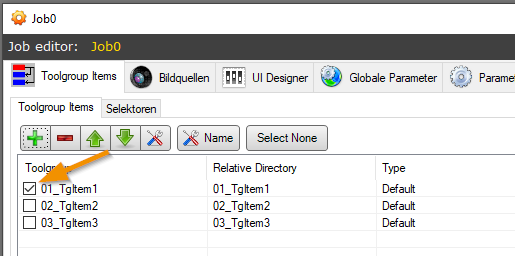General¶
Version¶
Each job instance has exactly one background thread for the evaluation of the tool group items. Therefore, only one evaluation can take place at a time. If a job is triggered while an execution is already running in the background, the caller waits until the job is released again and the desired execution can be started, or until the set timeout TimeoutWaitForJobFree is reached. In the latter case, execution is aborted with an error.
The actual execution procedure consists of the following steps:
The imageacquisition
The execution of the selected ToolGroup Items
Selection ToolGroup Items¶
A BV job can contain several ToolGroup items, but can only execute one at a time. There are several options for selecting the ToolGroup items.
Selection in the Job Editor¶
In the Job Editor the ToolGroup Items are selected via the CheckBox:

Selection for trigger via station¶
The PLC can also start a specific ToolGroup item via its ID when triggered. This function must be activated and configured in the configuration of the station.
In addition, the ToolGroup Item Selectors in the Job Editor offer even more flexibility, as the ToolGroup items are selected here based on additional PLC variables.
RunFromDir¶
When using RunFromDir global, an automatic selection of the ToolGroup item is made based on the file name.
Image feed¶
During triggering, input images can be passed to the job. This happens, for example, when triggered by a image-trigger-station or when loading stored images. In this case, there is no image acquisition from the image sources. Instead, each image source of the selected ToolGroup Item is assigned one of the passed images, which is then passed to the toolgroup. The mapping is based on the order of the passed input images and the order of the sources in the image-source-lists.
If the job is triggered without explicitly supplied input images, the job obtains them from the image sources. The process can be customized by parameters in the Settings tab of the Job Editor and has the following flow:
If own-lightsituation is set in the selected toolgroup item, the system waits until exclusive access to the required light channels is possible. If the wait time exceeds the set TimeoutLockLight, image acquisition and job execution will terminate with an error. If the light channels can be locked within the waiting time, the brightnesses are set according to the light situation.
The Image acquisition is executed from all sources that are marked as active in the ImageSource list of the selected ToolgroupItem. Depending on the set parameter GetImgsParallel, this is done in parallel for all sources, each in separate threads, or sequentially in the order of the sources. The duration of this step is monitored and limited by the setting TimeoutWaitForImages. When the time limit is reached, job execution is aborted with an error.
If the setting LightOffAfterJob is active, the brightnesses of the light channels of all light situations of the relevant image sources are set to
0.
Hint
The setting TimeoutLightSituationOnExposureEnd is passed to all affected image sources in step (2) and controls when the light channels are released again.
Warning
If image sources define lighting situations which access the same lighting channels, then image acquisition from the sources is implicitly synchronized across the lighting channels. If true parallel image acquisition is to occur, care must be taken to configure lighting appropriately. For example, by defining the lighting-situation at the level of the ToolgroupItem.